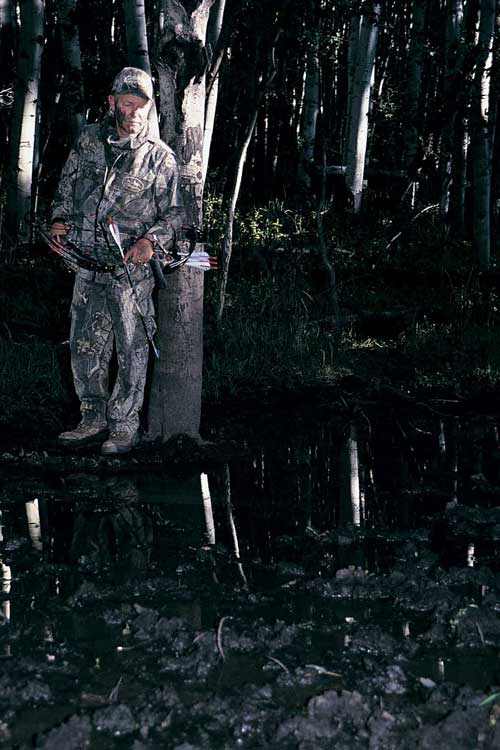 Wallows And Waterholes
Wallows And Waterholes
Mention decoying herd bulls at the local saloon during elk season and you may get some pretty unusual looks. Although Pitcher has had excellent results in his trials, decoys are just one trick among many unusual tactics he and his friends employ.
Decoys may seem like a wacky way to hunt elk, yet to many diehard Western elk hunters, treestands are just as outlandish. Eastern whitetail hunters know the benefit of patience and can employ many of their whitetail tactics to score.
Whether using an elevated stand or ground blind, scouting can be key. When you find a beaver pond, stock tank, or other water source elk use regularly, you might think you are into whitetail deer—only a lot bigger. You’ll find fresh tracks, droppings, and rubs during the rut. If you come upon a small pond or watery depression with fresh mud, carefully inspect nearby vegetation. Bulls often wallow in mud, pig-like, until they are caked with black muck. As they leave the hole, mud sticks to small saplings and brush.
When glassing elk early in the morning, look for bulls with black legs. This is a good sign they have just been wallowing. In arid cattle country, look for livestock with mud to its knees. Animals may be drinking at a hot elk wallow, perhaps a watering spot completely unknown to others.
Once you’ve located a water source, consider the wind and put up a stand. Elk often drink toward the end of shooting light, so keep your silhouette in mind. A ground blind can be effective and offers greater mobility if needed. A bull may bugle or be preoccupied with a cow allowing you to sneak in for a shot.
Keep’em Talking
Pitcher and his friends usually hunt in pairs. One of their secrets is to locate a bull by bugling or cow calling from a distance, then split up.
“If you pressure a herd bull he may leave his cows or push them away,” says Pitcher, reflecting on techniques that have paid off in past years. “This strategy requires one fellow to call enough to keep a bull vocal while the other hunter sneaks in silently.”
This tactic also targets herd bulls that tend to be very vocal. When one responds and stays put, flip a coin and go for the gusto. The stalking archer should have good camo, face cover or paint, good binoculars, and a cow call ready in case of detection.
Elk are normally noisy creatures, so tip-toeing around isn’t always necessary. Use game trails whenever possible and stay alert for cows and smaller bulls. If you are seen by a cow, or hear hooves thumping away, cow-call to assure the animal everything is OK. Above all, wind is the greatest obstacle to overcome and much more important than the noise factor. Wherever the bull is bugling, make sure you approach with the wind in your face—even if it means circling for a mile in dark timber. At dawn and dusk, air currents consistently flow downhill. Keep that in mind as you approach Mr. Big.
If you can’t close on a bull that may be call-shy, try “raking” a tree. When bulls get feisty with each other, they demolish the nearest tree, breaking limbs and branches. There is no “correct sound” to emulate, so you can’t goof it like a mouth call. If the bull approaches, he’ll be looking for a fight, so always be physically and mentally prepared. If it spooks on approach or sees you draw the bow, a quick cow call can often stop it.
Next: Beat The Heat, Prepare To Succeed, 7 Sneaky Tricks






